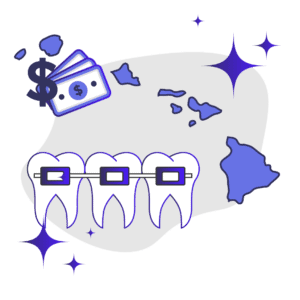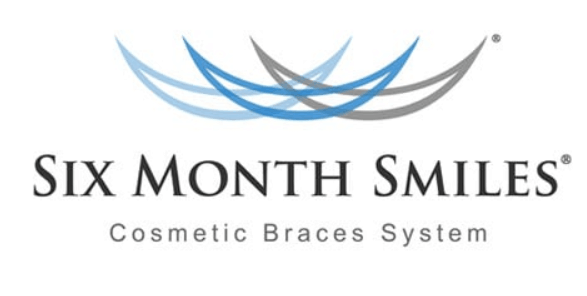
Braces have been around for decades, and there’s a good reason they remain a go-to teeth straightening option for adults everywhere: they work. But one thing that isn’t so certain about braces is treatment cost. It isn’t a one-size-fits-all number — it depends on a variety of factors, including your location.
Believe it or not, your home state plays a big role in determining what you’ll pay for braces. In Hawaii, you’ll pay a different amount than you would in Texas, Wisconsin, or any other state. This guide will cover all the little details that can influence your braces price, so you’ll know what to expect when you step into the orthodontist’s office.
Table of Contents
Cost of Adult Braces in Hawaii vs. National Average
According to the American Dental Association, the national average cost for adult braces treatment is $4,800 to $7,135. Hawaii might be a tropical paradise, but its geographic isolation and high cost of living mean that you’ll often pay more for orthodontic treatment.
| Area | Cost in Hawaii | National Average |
|---|---|---|
| Urban | $5,000–$8,500 | $5,250 |
| Suburban | $5,000–$9,000 | $5,500 |
| Rural | $5,000–$8,000 | $5,000 |
These ranges are estimates based on what we know about adult braces costs and some information from a few Hawaii-based orthodontists. But they should give you a general sense of what you might pay.
Why Are Braces So Expensive?
There’s no getting around the fact that braces are expensive. But that’s because they’re one of the most consistent and effective treatments available.
They might be visible and somewhat intrusive, but braces’ major benefit is their sturdiness. You can’t take them out like clear aligners, so they eliminate the potential for user error. Sure, you need to avoid excessively sticky or gummy foods, but in return, you’re getting surefire results. Metal brackets and wires give an orthodontist incredible control over your teeth, and during routine office visits, they can make adjustments to deliver the perfect results.
Braces require routine trips to the orthodontist over the course of a 12–24 month treatment timeline, and each visit costs money. Orthodontist offices have overhead costs like rent, utilities, and staff, which translate to patient fees. And don’t forget that you’re also paying for the orthodontist’s expertise and time. However, as you’ll find out, the price you ultimately pay is subject to a variety of influences, including where you live.
Looking For Affordable Orthodontic Treatment in Hawaii?
Braces are a time-tested treatment, but their price tag doesn’t fit every budget. That’s why adults with mild misalignments sometimes opt for at-home aligners instead.
By cutting office visits out of the equation, home aligner companies like Byte and SmileDirectClub offer comparable services for lower prices. We’ve done extensive research on home aligner options. Our in-depth guide provides all the info you need to find the best option for your smile.
What Factors Influence the Cost of Braces?
Braces are typically expensive. But exactly how expensive is a more complicated question. Multiple factors can influence your final bill. Some are based on your location, others are constant across state lines. We break them all down in detail below.
Condition Severity
This is the most significant price-determining factor. A minor case of crowding or spacing simply takes less time and aligners to correct than a severe case of crossbite. The fewer office visits your teeth require, the less you’ll pay. During your initial consultation, your dentist/orthodontist can evaluate your teeth and estimate how long your treatment might take.
Type of Braces
Orthodontic technology has advanced significantly over the past couple of decades, and standard metal brackets aren’t the only option anymore. For instance, you can opt for ceramic braces that blend in with your teeth, or lingual braces that sit behind your teeth. Each of these is less noticeable than traditional braces, but they’re also more expensive. Ceramic braces can cost up to $8,000, while lingual braces can be between $8,000 and $13,000.
Region
In general, orthodontic care costs more on the coasts and less in the middle of the country. The northeast is particularly expensive, while southern states like Alabama and Mississippi boast some of the nation’s lowest costs. Taxes can also play a role. The state will add sales tax to your total braces cost, and higher corporate taxes might cause your orthodontist to accommodate by raising prices.
Hawaii is more than 2,400 miles away from California, and it’s pretty isolated in the middle of the Pacific Ocean, so shipping to Hawaii is expensive. This means your orthodontist’s equipment and supplies will cost more, which may lead to higher braces prices.
Additionally, the Hawaiian islands are fairly small, and a lot of potential real estate is dedicated to tourism and state parks. There isn’t a lot of office space, which makes rent and property more expensive. Utilities aren’t cheap either, especially electricity. All of these bills add up for your orthodontist, making it more expensive to run their business, often causing them to raise their rates.
But there is a silver lining: Hawaii’s taxes aren’t staggering. You’ll pay a 4% state sales tax (plus any local sales taxes) on your braces. The state’s corporate income tax is 4.4%–6.4%, which likely isn’t so much that it will cause your provider to raise their prices.
Urban, Suburban, or Rural?
Not only are orthodontic costs different for each state, but they also vary based on your location within the state. Urban areas, for example, often have a higher cost of living, and it’s less expensive to live in a small town. Do you have high rent and utility payments? Then your dentist or orthodontist likely does too. Higher overhead costs usually result in more expensive orthodontic treatment.
Urban
Honolulu, located on Oahu, is Hawaii’s only major city, and it’s not cheap to live there. As we outlined above, everything costs more in Hawaii because of the state’s remoteness and lack of real estate. So be prepared to spend some money when you go in for braces. Depending on your specific condition and your orthodontist’s rates, they could end up costing you up to $9,000. On the plus side, Honolulu has a solid number of orthodontists, so you can compare prices and hopefully find one that fits your budget.
Suburban
Oahu doesn’t just house Honolulu, but most of Hawaii’s other towns. These aren’t necessarily suburbs; rather, each one is independent, albeit pretty close together (Oahu isn’t that big). None of these towns have more than 50,000 residents. Big Island and Maui each have a couple of mid-sized towns too, like Hilo and Kahului. Big Island typically has the lowest cost of living, and Oahu has the highest, and their orthodontic fees often reflect that. Despite its higher average prices, Oahu also has the most orthodontist options.
Rural
Around 93% of the land in Hawaii is classified as rural, which means there are plenty of small towns on every island. These towns often have a lower cost of living than Honolulu and Hawaii’s mid-sized towns, but they’re also more remote and don’t usually have an orthodontist. Fortunately, you can drive across or around any of these island’s pretty easily. Oahu, for example, is only 44 miles long, so you can get from one end to the other in just over an hour.
Local Competition
When you have numerous orthodontists in an area, they each need to stay ahead of the competition and attract new customers. Many times, this means lower prices and special offers or sales. So, if there’s a high concentration of orthodontists in your area, it can mean lower prices, giving you the ability to “shop around.”
If you live in Honolulu, you have numerous orthodontist options, and these competitors are prone to set themselves apart by offering discounts or other promotions. If you jump on one of these sales, you can potentially offset the higher costs of treatment in urban areas. On Big Island, Maui, or Kauai, there are fewer providers to compete for your business, so you probably won’t see as many special promotions or deals.
But that’s not to say that rural orthodontists completely avoid discounts and special offers. Some might offer them just to show appreciation for their customers or drum up new customers.
Orthodontist Experience
Like most industries, in orthodontia, seasoned professionals can charge more for their services than relative newcomers. So, if your orthodontist has been administering braces for years, you might end up paying a bit more. For this reason, it can sometimes be helpful to “shop around” to weigh your options if you have multiple orthodontists nearby.
Managing Treatment Costs
If you’re feeling overwhelmed by treatment costs, you’re not alone. Take comfort in the fact that in most cases, you won’t have to pay the entire amount up front. Here are some ways you can make that price tag seem a little more manageable:
Review Your Insurance Plan
Braces for children and adolescents are partially covered by most dental insurance plans. However, plans don’t often cover costs for anyone over 18, unless they include orthodontic benefits. But you don’t want to begin treatment expecting help from your insurance provider, only to find out that it’s not coming. So don’t commit to braces without first reviewing your insurance plan and contacting your provider.
Some orthodontist offices also accept payments directly from an FSA or HSA if you have one. Consult your dentist or orthodontist to see how they handle these payments.
Search for Sales and Discounts
You won’t likely see your orthodontist running sales or promotional discounts on braces. But sometimes they’ll offer perks to go along with your treatment, like teeth whitening or a percentage off your next visit. It certainly can’t hurt to ask. Sometimes you can even find deals on Groupon.
Universities with dental and orthodontic schools will also offer discounts if you don’t mind a resident administering your treatment. These individuals are qualified and on the track to becoming state-licensed orthodontists. Plus, they’re overseen by professors and experienced dental professionals, so you can be sure you’re receiving quality care.
Unfortunately, Hawaii doesn’t have any universities with dental programs, so you won’t have this option.
Inquire about Financing Options
Most orthodontist offices offer financing plans that break your costs into manageable monthly payments. Typically you won’t need to pay the entire lump sum upfront. The terms of these plans vary, so you should speak with your orthodontist about the financing options they offer.
If your orthodontist’s options aren’t ideal, you can look into third-party dental financing companies like CareCredit or beWell, which finance everything from routine dentistry to complex orthodontic procedures.
Discuss Aftercare in Advance
Even after the brackets come off, teeth tend to shift back to their old positions. Aftercare retainers keep that from happening. After your teeth have been freed, you’ll have a perfect new smile, and you’ll need to purchase a retainer to protect it. Retainer costs vary, but you can usually get one for $200–$600. This, too, depends on your specific orthodontist.
Because your dentist can make tweaks and course corrections throughout your treatment, they can ensure that you’ll get a perfectly straight smile, and they won’t remove your braces until then. That said, some teeth simply don’t move quite as expected, so your orthodontist might need to add attachments and extend your treatment timeline, which will cost more. Talk to your orthodontist about their mid-treatment refinement policies before you begin.
3 Affordable Braces Alternatives
Braces are one of the most effective and powerful options out there, but they’re not ideal for everyone. Whether you’re unsure about the price tag or the procedure, here are three braces alternatives we think are worth your time.
1. Six Month Smiles
Maybe you want to get the sturdiness and power of braces, but avoid the metal wires and lengthy treatment time. If so, you might consider Six Month Smiles. They’re an in-office brand that uses clear wires and brackets for a more discreet appearance. Or, if you want to avoid brackets and wires altogether, they recently expanded their services to offer clear aligners as well.
With an average price range of $3,500–$5,000, Six Month Smiles costs less than traditional braces in most cases. Plus, as their name suggests, the average treatment time is just six months, so you get the best of both worlds – one-on-one care and an abbreviated timeline. But on the flipside, Six Month Smiles isn’t suitable for as wide a range of conditions as traditional braces. If you have a severe case of misalignment, Six Month Smiles might not work for you.
2. Byte
Byte is a home teeth straightening service that sells custom clear aligners for less than half the price of braces or Invisalign. You'll receive your full aligner series in the mail, then administer treatment from the comfort of your home, no office visits required.
Like Six Month Smiles, byte can treat mild-to-moderate cases of misalignment. But unlike Six Month Smiles, Byte’s aligners are nearly invisible and come with the HyperByte — a high-frequency vibration device that can make treatment more efficient for some customers. We also like their lifetime guarantee, which promises users free revision treatment if their teeth ever move out of alignment.
If you think Byte might be a good fit for your needs, check out our comprehensive review for a closer look at their service offerings, customer reviews, and a whole lot more.
3. Candid
Candid started out as an at-home teeth straightening service like Byte, but has since transitioned to a hybrid model that more closely resembles in-office treatment options like Invisalign.
With Candid, your treatment will be administered by a local dentist, but you'll only need to visit them in person a couple of times throughout the entire process — much less often than braces. That said, you'll still get the clinical oversight you need thanks to Candid's proprietary CandidMonitoring™ system, which allows you to submit scans of your teeth for review every two weeks from the comfort of home.
Candid treatment typically costs less than braces, but on the flip side, it's more limited in the scope of conditions it can address. Candid's treatment plans aren't currently designed to incorporate rubber bands or dental attachments like braces can. However, if you're looking to correct a mild or moderate case of misalignment, Candid could be a great option for you.
Read our review of Candid to learn more.
Conclusion
Getting braces is a big move, a significant step on your journey toward a new smile. But it’s also a big expense, and uncertainty about your treatment’s price tag can be stressful. Fortunately, with the knowledge you’ve gained from this guide, you can get a better sense of whether braces are a viable option.
Keep in mind, though, that the only way to get a truly accurate cost for your braces in Hawaii is by visiting your orthodontist. Although braces might seem expensive, there are ways to make them more affordable, like financing, discounts, and insurance. In the end, if you decide that they’re simply not right for you, there are plenty of other options available. No matter which route you take, your destination is the same: a brand new, photo-ready smile.



Join The Discussion: